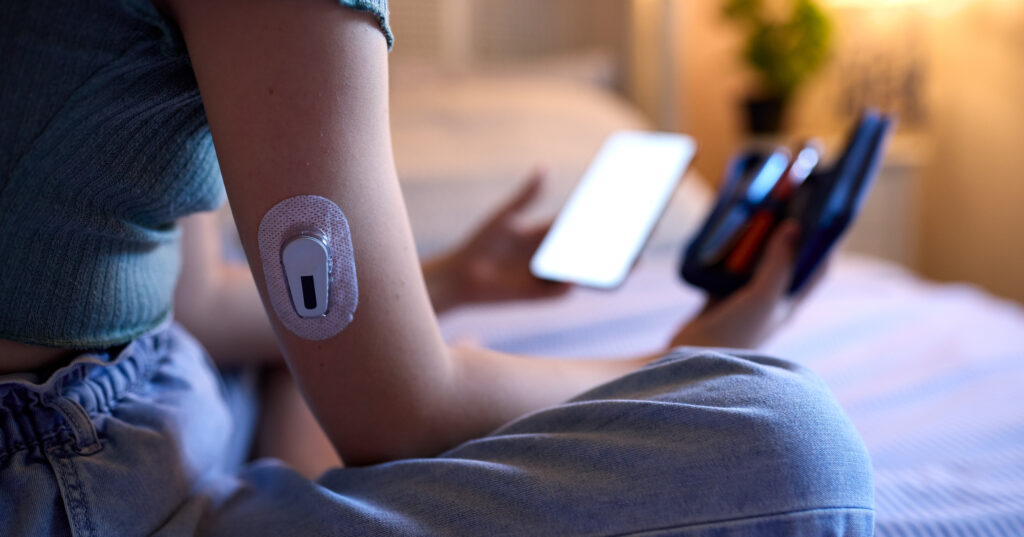As a physician, do you feel that your office spends multiple calls trying to assist your diabetic patients with their high blood sugar? Remote patient monitoring (RPM) can remove that burden in three easy steps: (1) a wearable sensor detects high blood sugar and notifies an RPM nurse; (2) the nurse contacts the patient and evaluates them per office protocols; and (3) the nurse refers the patient back to the office for follow-up in a safe time frame, pending their assessment over the phone.
In other words, you can either continue to play phone tag without getting reimbursed, or you can implement a powerful RPM program that will increase your patient satisfaction, health outcomes, and practice revenue.
Here are a couple of scenarios that outline how this works.
Scenario 1: High Blood Sugar Without a Remote Patient Monitoring Program
A patient with type 2 diabetes manages her condition diligently and monitors her blood sugar at home. One day, she wakes up feeling fatigued and notices a higher-than-usual reading of 300 mg/dL on her glucometer. Concerned about this sudden spike, she decides to contact her endocrinologist’s office for guidance. After five phone calls between the patient, her physician’s front office, nursing staff, and finally her physician, she ends up being scheduled for an in-person evaluation the next day.
This back-and-forth process of assessing her concerns and scheduling an appointment took several interactions that not only delayed her care, but also created a series of administrative hurdles for the practice.
Scenario 2: High Blood Sugar With a Remote Patient Monitoring Program
Let’s imagine that this same patient was actually enrolled in a remote patient monitoring program as part of her ongoing diabetes management. The program would involve the use of a wearable sensor that could record her blood sugar levels and transmit these readings electronically to a nurse who would be tasked with reviewing this data.
On the same morning that the patient woke up feeling fatigued, her RPM sensor would have automatically flagged her glucose reading, which a nurse would have received and used to contact the patient for evaluation and guidance.
In this version of events, the patient’s care process has been streamlined through the use of a single phone call.
Without RPM, a patient can spend multiple attempts trying to get a definitive answer to a single health concern. This delay can potentially mean the difference between life and death, especially if the practice takes longer than a day to respond.
Considering that roughly 1 in 10 Americans have diabetes (approximately 38 million), the chances are high that your practice will a) treat patients with this condition, and b) improve their health care by using RPM.
How to Evaluate a Remote Patient Monitoring Vendor
If you’re ready to implement your own RPM program, it’s important to review key regulatory factors before partnering with a vendor. This article highlights billing practices, device pricing, reporting procedures, location of services, contracts, staffing, and patient interaction requirements that you’ll want to keep in mind. Its accompanying checklist can help you in the vendor evaluation process so that you maintain compliance, improve patient safety, and reduce practice liability.
Benefits of Remote Patient Monitoring
There are several key reasons why remote patient monitoring can benefit your practice beyond the example case study above.
- Reimbursements for RPM can be significant, with CMS approving up to $120 per patient per month.
- Remote patient monitoring offers access to quality medical care for individuals facing barriers like limited transportation or lower income, thus improving health equity.
- Practice or hospital usage is reduced by facilitating home-based care with RPM’s wearable sensors, which frees up additional provider resources.
Challenges of Remote Patient Monitoring
Managing patient data sent from RPM devices can be difficult if you don’t have adequate staff who are trained to review it. Outsourcing this task to triage nurses can ensure this data is analyzed properly, and that the appropriate billing codes for reimbursement are applied.
TriageLogic has a medical call center of registered nurses who can monitor patient vitals transmitted by RPM sensors, identify changes in patient health, and coordinate the necessary responses between your patients and your providers.
Our data review can also integrate with your in-house software, which means you’ll have greater interoperability, security, and compliance without the need to purchase any additional tools or services.
The Path to Patient-Centered Care
By leveraging RPM technology, your practice can efficiently monitor patients with chronic conditions like diabetes, identify concerning health readings, and intervene quickly. This not only improves patient outcomes through timely care, but also relieves your staff from fielding multiple phone calls for the same concerns.
TriageLogic’s turnkey RPM solution can improve patient care and increase your practice revenue with minimal effort. Contact us today to learn about a program.
About TriageLogic
TriageLogic is a URAC-accredited, physician-led provider of top-quality nurse telehealth technology, remote patient monitoring, and medical call center solutions. Founded in 2007, the TriageLogic Group now serves more than 22,000 physicians and covers over 42 million lives nationwide.






